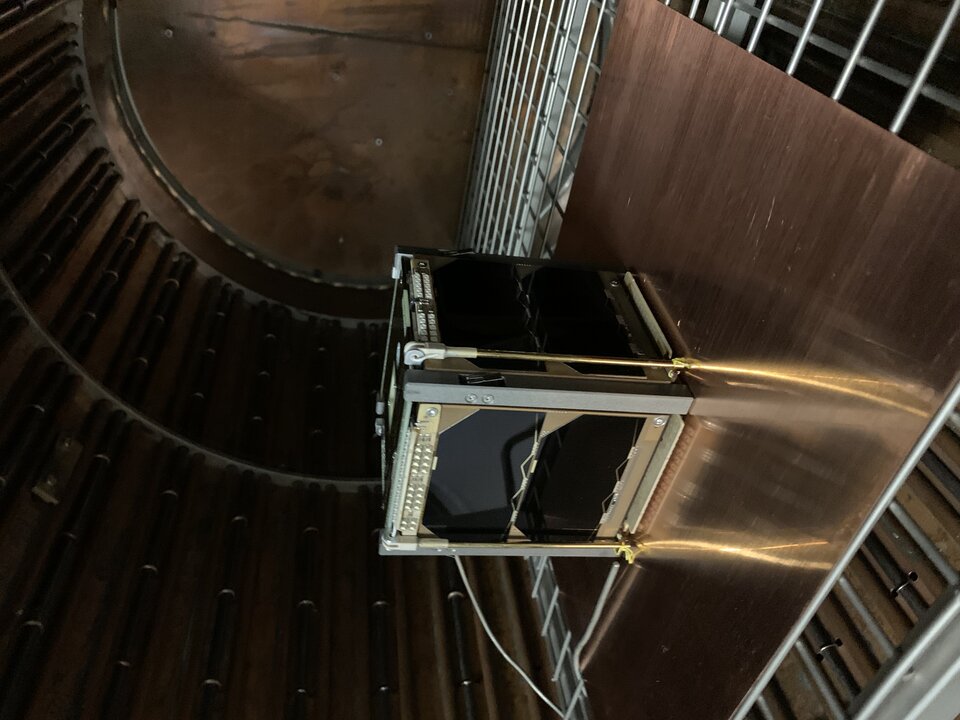"Shake and bake" has concluded: LEDSAT team has completed environmental tests
The LEDSAT team, participating in the second round of ESA’s Fly Your Satellite! programme, has completed their crucial structural qualification and thermal-vacuum tests, demonstrating their CubeSat’s readiness to continue with its mission to space!
The LEDSAT CubeSat is a 1U CubeSat developed by Sapienza University in Rome, Italy to offer space Aerospace engineering students the opportunity to participate in a satellite mission from initial design of the CubeSat to the disposal after the mission has ended.

LEDSAT is fitted with LED boards on the faces of the satellite to allow ground based optical telescopes to observe and track the satellite in orbit. Additionally, the team will also use the LEDs to get information on the attitude of the satellite and to test the on-board LED-based technology for an encoded light communication strategy.
Every team on the Fly Your Satellite! programme has to put their CubeSat through a series of environmental tests to verify their CubeSat will withstand the vibrations experienced during launch and the extreme temperature and pressures of being in Low Earth Orbit.
The ESA Education Office provides support for teams to complete these intensive tests, which ordinarily are carried out at the Office’s CubeSat Support Facility (CSF) at ESEC-Galaxia in Belgium, with the full support of ESA operators. Unfortunately, the events of 2020 did not allow the LEDSAT team and their satellite to travel to Belgium, and this exceptional year led to the execution of testing at University facilities in Rome, with remote support provided by ESA technical experts before and after the tests and live connections to the ESA Education office during the tests themselves.
At the end of November 2020, the LEDSAT team started the environmental test of their Proto Flight Model (PFM) which begun with vibration tests, at the Vibration Experimental Laboratory at Sapienza University. The PFM was placed on a shaker armature and shaken on all three axes to qualify it for the launch on-board a rocket – a launch that is planned for 2021. The team worked long hours to analyse the results and move swiftly towards the next steps in the environmental test campaign (ETC).
A FYS project member travelled safely to Sapienza University to inspect and perform a fit check of the LEDSAT CubeSat with a test deployer. With everything looking good, the team proceeded.
A “bake-out” was then performed, where the CubeSat is placed in a vacuum chamber for multiple days at temperatures of 40˚C to ensure outgassing of any volatile compounds.
With the bake-out completed, the CubeSat was placed in the thermal vacuum chamber. Inside the chamber, the satellite experienced several thermal cycles both hot and cold, simulating the conditions that it will meet in orbit. During the time in the thermal vacuum chamber, the team carried out several functional tests to ensure their satellite was working as expected. After 5 days in the chamber, the team performed a final functional test and ended the test just in time for Christmas.

The LEDSAT team analysed the data from the TVAC test and with a Post Test Review of the results with the Fly Your Satellite! project team and ESA experts, the thermal vacuum (TVAC) test was deemed successful.
A member of the LEDSAT team expressed his thoughts on the ETC experience: ”For the TVAC campaign I carried out a thermal analysis on how the system behaves during the tests and helped in writing the report document regarding it. Although I participated remotely, following the steps from home was helpful in order to define how a test campaign is carried out and before that, the preparations it can undergo. In addition, it was satisfying viewing the results confirm the analysis carried out before.”
The team is now in the final review prior to launch – the Flight Acceptance Review or FAR. In this stage, the team has delivered the final documentation for their mission and a panel of ESA experts will review their mission in great detail and determine if it is ready for launch.
If the mission is ready, the team gets a “Ticket to Orbit” allowing them to move to the next phase of the programme, Launch Your Satellite!
To stay up-to-date with all the latest Fly Your Satellite! news, visit our website.


